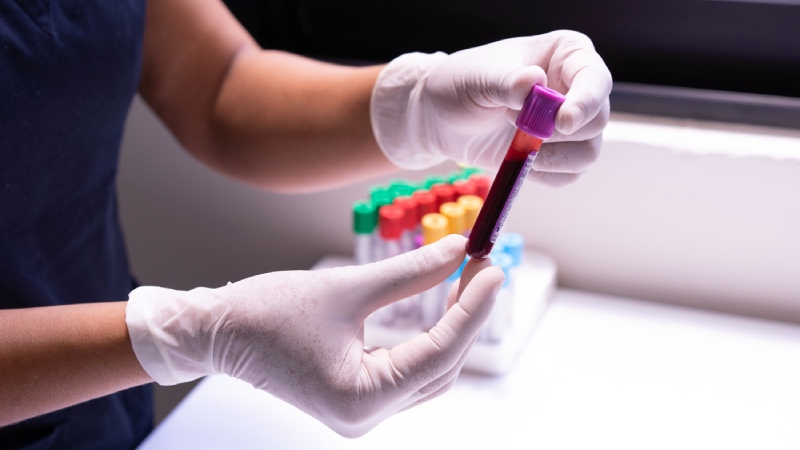27 December, 2021
Liquid biopsy shows its utility in the analysis of cancer

One of the big challenges in the treatment of cancer is its heterogeneity. Tumours can present different mutations and change with time, which means that not all treatments are effective or they generate resistance. That’s why it is important to carry out follow-ups that allow us to identify changes as they are produced. However, getting the precise samples to carry out this analysis via a tissue biopsy isn’t always easy. That’s why, in the last few years, a new method has been developed which allows to analyse tumoural DNA circulating in the blood in order to carry out this follow-up and analysis of cancer in an easy and simple way. This is known as liquid biopsy.
YOU MAY BE INTERESTED IN…
The preliminary results from the CLIMB360 study, developed by Dr. Aleix Prat and Dr. Javier García Corbacho, both professionals in the Hospital Clínic Group at barnaclínic+, have shown that using this technique of liquid biopsy to get the prospective genomic profile and in real time from patients is viable, fast and it helps to identify therapeutic targets approved and evaluated in clinical trials. These results have been published in Annals of Oncology, the magazine from the European Society for Medical Oncology (ESMO).
In order to carry out this study the genetic profile of 321 oncological patients with different solid tumours were studied –pulmonary, pancreatic, colorectal, cholangiocarcinoma, breast, thyroid and salivary gland carcinoma– via liquid biopsy in the blood with Guardant360, a test capable of analysing 74 genes via massive sequencing techniques. The study, which started in September 2020, established a genomic sequencing of tumours from these patients over 18 months. They were looking to be able to select the most appropriate therapy according to the evolution of the disease in each patient.
YOU MAY BE INTERESTED IN…
THE FASTEST AND SIMPLEST LIQUID BIOPSY
Getting samples from solid tumours via a biopsy can be a complex and not always fast process. The results of a tumoural biopsy can take more than a month to come in, too long for many patients who might have to rapidly change therapy according to the evolution of their disease. As well as this, in certain types of cancer, such as lung cancer, carrying out a tissue biopsy is very expensive.
On the other hand, the results of a liquid biopsy are much faster, obtained in just 9 days. And contrary to tumoural biopsies, which are invasive and potentially painful, a liquid biopsy only requires an extraction of 20ml of blood. This also allows us to carry out repeatedly and to perform a more precise follow-up of the evolution of the tumour at the same time which doesn’t cause excessive discomfort for the patient.
The results of a liquid biopsy are much faster and only require the extraction of 20ml of blood
WHAT IS A LIQUID BIOPSY IN THE BLOOD FOR?
On occasions, when there is a tumour, genetic material is released, cancerous proteins and cells in the bloodstream. Currently with just one extraction of blood it’s possible to detect circulating DNA, tumoural cells and other compounds of the tumour. The techniques for the detection of circulating DNA and tumoural cells should be ultrasensitive, given that these compounds and cells are found in extremely small proportions in the blood. The cancerous cells in circulation can become established in another part of the organism, generating a metastasis. The detection of tumour cell DNA allows us to determine the evolution of the disease and select the treatments in order to treat the tumour specifically.
HOW IS THE LIQUID BIOPSY CARRIED OUT?
With Guardant360. It’s a liquid biopsy test capable of analysing 74 genes via massive sequencing techniques. This way mutations, genetic copies, genes which could develop solid tumours and hereditary cancers and microsatellite instabilities, which are short DNA sequences that don’t encode for any gene but constitute genetic markers in some cancers, are identified. The simplicity of the test is quite high given that in the study genomic alterations were detected in practically 90% of the cases, which opens the door to a potential therapy directed towards every type of cancer.
Liquid biopsy must be interpreted in order to select the correct treatment. That’s why groups of specialists have started to be created (tumour molecular board) which revise each case and emit a joint recommendation. Medical Oncology is directed towards a personalised prescription for the medication for which, without doubt, the circulating DNA analysis will form part of the future consultations. “This technique, which allows us to determine in real time the genetic characteristics of the tumour, is, without doubt, going to increase the survival rate of our patients”, comments Dr. Javier García Corbacho.LE PUEDE INTERESAR…
92P First-results of the CLIMB360 study, a prospective molecular screening program across multiple cancer types based on circulating tumor DNA (ctDNA)
J. Garcia-Corbacho, I. Victoria Ruiz, L. Angelats, S. Castillo, M. Nogué, A. Prat

